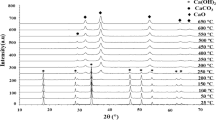In this work, we have characterized four types of porous carbon material by N2 adsorption at 77 K and CO2 adsorption at the freezing point. The results show that both the BET equation based on the N2 adsorption isotherm and the D-A model parameters obtained from the CO2 adsorption isotherm are not applicable for analyzing the CO2 adsorption characteristics in porous carbon materials. The density functional theory (DFT) analysis results of the CO2 adsorption isotherm show that the adsorption of CO2 in a porous carbon material occurs mainly in micropores, and the micropore volume calculated by the DFT model is in good agreement with the adsorption isotherm. Therefore, the DFT model based on the CO2 adsorption isotherm is a reliable characterization method and can accurately reflect the CO2 adsorption characteristics of activated carbon.





Similar content being viewed by others
References
T. M. McDonald, J. A. Mason, X. Kong, E. D. Bloch, D. Gygi, A. Dani, V. Crocella, F. Giordanino, S. O. Odoh, W. S. Drisdell, B. Vlaisavljevich, A. L. Dzubak, R. Poloni, S. K. Schnell, N. Planas, K. Lee, T. Pascal, L. F. Wan, D. Prendergast, J. B. Neaton, B. Smit, J. B. Kortright, L. Gagliardi, S. Bordiga, J. A. Reimer, and J. R. Long, “Cooperative insertion of CO2 in diamine-appended metal-organic frameworks,” Nature, 519, 303-308 (2015).
J. W. F. To, J. He, J. Mei, R. Haghpanah, Z. Chen, T. Kurosawa, S. Chen, W. G. Bae, L. Pan, J. B. H. Tok, J. Wilcox, and Z. Bao, “Hierarchical N-doped carbon as CO2 adsorbent with high CO2 selectivity from rationally designed polypyrrole precursor,” J. Am. Chem. Soc., 138(3), 10011009 (2016).
Y. S. Bae and R. Q. Snurr, “Development and evaluation of porous materials for carbon dioxide separation and capture,” Angew. Chem. Int. ED., 50(49), 11586-11596 (2011).
F. Liu, K. Huang, Q. Wu, and S. Dai, “Solvent-free self-assembly to the synthesis of nitrogen-doped ordered mesoporous polymers for highly selective captured and conversion of CO2,” Adv. Mater., 29(27), 17001445 (2017).
S. C. Qi, Y. Liu, A. Z. Peng, D. M. Xue, X. Kui, X. Q. Lui, and L. B. Sun, “Fabrication of porous carbons from mesitylene for highly efficient CO2 capture: A rational choice improving the carbon loop.” Chem. Eng. J., 361, 945-952 (2019).
L. Yue, L. Rao, L. Wang, L. An, C. Hou, C. Ma, H. DaCosta, and X. Hu, “Efficient CO2 adsorption on nitrogen-doped porous carbons from D-glucose,” Energy Fuels, 32 (6), 6955-6963 (2018).
E. S. Kikkinides, R. T. Yang, and S. H. Cho, “Concentration and recovery of CO2 from flue gas by pressure swing adsorption,” Ind. Eng. Chem. Res., 32, 2714-2720 (1993).
S. Sircar, T. C. Golden, and M. B. Rao, “Activated carbon for gas separation and storage,” Carbon, 34(7): 1-2 (1996).
J. Zhang, Y. C. Zhang, W. Bai, et al., “Novel adsorbents for CO2-PSA and properties research,” Low Temp. Special Gases, 20(2), 26-29 (2002).
M. Kruk, M. Jaroniec, R. K. Gilpin, et al., “Nitrogen adsorption studies of coated and chemically modified chromatographic silica gels,” Langmuir, 13(3), 545-550 (1997).
S. Brunauer, P. H. Emmett, and E. Teller, “Adsorption of gases in multimolecular layers,” J. Am. Chem. Soc., 60(2), 309-319 (1938).
M. M. Dubinin, “The potential theory of adsorption of gases and vapors for adsorbents with energetically nonuniform surface,” Chem. Rev., 60(2), 235-241 (1960).
G. Hovath and K. Kawazoe, “Method for calculation of effective pore size distribution in molecular sieve carbon,” J. Chem. Eng. Jpn., 16(6), 470-475 (1983).
A. Saito and H. C. Foley, “Curvature and parametric sensitivity in models for adsorption in micropores,” AIChE J., 37(3), 429-436 (1991).
J. Liu, S. Z. Qiao, H. Liu, et al., “Extension of the Stober method to the preparation of monodisperse resorcinol-formaldehyde resin polymer and carbon spheres,” Angew. Chem. Int. Ed., 88, 3336-3341, https://doi.org/10.1002/anie.201102011 (2011).
S. Stock, H. Bretinger, and W. F. Maier, “Characterization of micro- and mesoporous solids by physisorption methods and pore-size analysis,” Appl. Catal., 174(2), 137-146 (1997).
M. M. Dubinin and V. A. Astakhov, “Development of the concepts of volume filling of micropores in the adsorption of gases and vapors by microporous adsorbent,” Russ. Chem. Bull., 20(1), 3-7 (1971).
P. I. Ravikovitch and A. V. Neimark, “Characterization of nanoporous materials from adsorption and desorption isotherms,” Colloid. Surf. A: Physicochem. Eng. Asp., 187-188(31), 11-21 (2001).
A. V. Neimark and P. I. Ravikovitch, “Capillary condensation in MMS and pore structure characterization,” Micropor. Mesopor. Mater., 44-45, 697-707 (2001).
M. Kruk, M. Jaroniec, and A. Sayari, “Application of large pore MCM-41 molecular sieves to improve pore size analysis using nitrogen adsorption measurements,” Langmuir, 13(26), 6267-6273 (1997).
Author information
Authors and Affiliations
Corresponding author
Additional information
Translated from Khimiya i Tekhnologiya Topliv i Masel, No. 6, pp. 57 – 61, November – December, 2020.
Rights and permissions
About this article
Cite this article
Wei, Y., Wang, J., Gu, C. et al. The Relationship between CO2 Adsorption and Microporous Volume in a Porous Carbon Material. Chem Technol Fuels Oils 56, 932–940 (2021). https://doi.org/10.1007/s10553-021-01210-5
Published:
Issue Date:
DOI: https://doi.org/10.1007/s10553-021-01210-5




